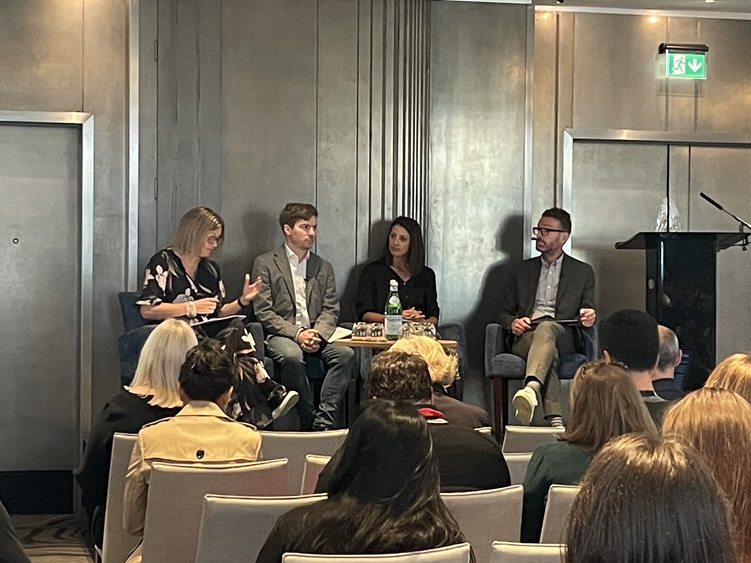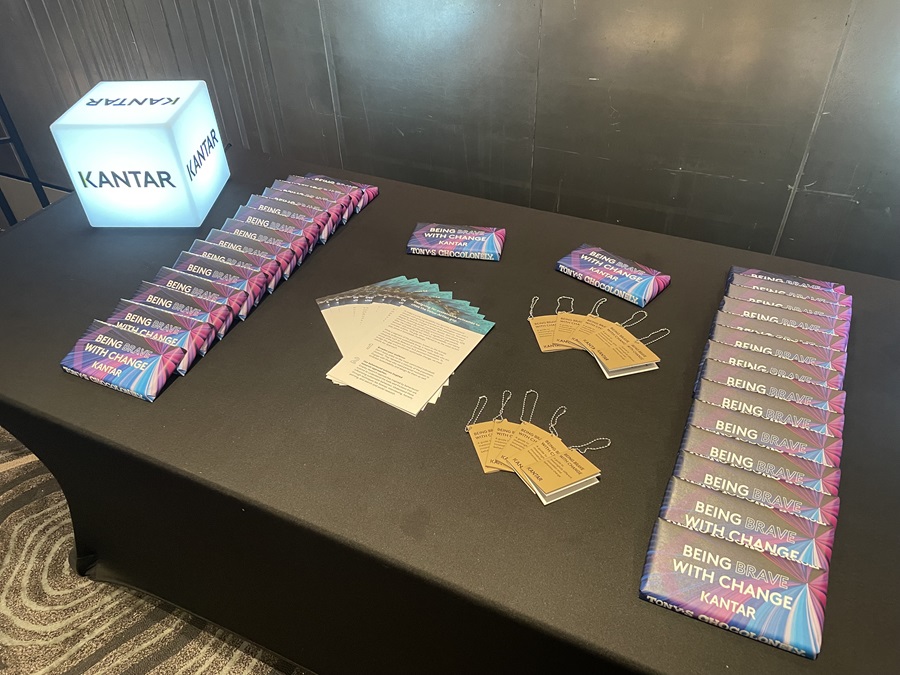Kantar was delighted to sponsor the 2023 MRS Behavioural Science Summit and play a key role in facilitating the sharing of knowledge from across the industry. It was a day of inspiration, education and action as agencies and clients further championed the use of Behavioural Science in helping brands innovate and grow!
Throughout the day a few key messages shone through, reinforcing why Kantar believes Behavioural Science thinking is key to unlocking meaningfully different growth for brands.
Example: BlackBerry in the early noughties was the new and shiny mobile phone that everyone wanted. It was worth an estimated £2.2 trillion. In 2007 the consumer context changed with the launch of the iPhone, which whilst dismissed BlackBerry as being unsecure, with poor battery and a clunky digital keyboard, went on to replace BlackBerry as the number one mobile device. The consumer context: having one operating platform that connects all your communication and entertainment needs, was king for Apple’s success.
Example: We might think that everyone buying an electric vehicle wants to help the environment, but some may be looking to que status or tap into their need for thrill. As marketeers, we need to understand this and adopt our product and comms accordingly.
Example: By immersing into socialising moments through qualitative research we identified that when socialising, everyone wants to feel part of the group, be included in the rituals of ‘the cheers’, have a glass in their hand to anchor themselves in the conversation; but not everyone wants to feel the effect of alcohol. With this knowledge of consumers values, we can design no/ low alcohol that connects with real people and enable them to be part of the group and not compromise on their values.
Example: Rumour has it that James Dyson tested 5,271 prototypes before he created the first market-ready Dyson vacuum. From the vacuum he has continued his innovation journey to include Dyson hairdryers, heaters, and fans. What’s next?
We know consumers want to live sustainably, but it is hard to realise these good intentions. There are many frictions in the way that transcend category and can stop brands from innovating for sustainability.
The 4 Big C’s that are frictions to consumers sustainable behaviour …
Too much …
- Cost. “I do not want to / can’t afford to pay more for sustainability. Especially in a cost-of-living crisis.”
- Compromise. “Sustainable products are never as good, as I do not want to compromise on quality.”
Not enough …
- Convenience. “I am busy, and I don’t want to do something different that requires more effort or go out of my way to find a different product.”
- Clarity. “I don’t know what is in it for me, I don’t think my small action can make a difference, I don’t know why the brand is doing this”?

But there is hope, here is some advice from our experts at Kantar, Reckitt, and The Cambridge Institute for how brands and innovators can close the gap …
Consumers want brands to act and do something [64% of consumers globally say it is businesses’ responsibility to solve climate and environmental issues] (Source: Sustainable Sector Index 2022) but they know it is a journey and don’t expect brands to have all the solutions or to have done everything yet. The ask; be transparent about what you are doing, why you are doing it and what is in it for the consumer.
Sustainable innovation can be a Win, Win, Win. For the Consumer, for Brands and for the Planet. Alex Peters, Global Purpose Lead at Reckitt provides a fantastic example of this from the laundry detergent category. Transitioning consumers from washing at 40 or 60 degrees to washing at 20 degrees. Despite consumers being hesitant as to the efficiency of washing at a lower temperature, Reckitt built for behaviour change by designing an effective product for a 20 degrees wash, reassuring consumers of the product efficacy, and providing additional benefits of clothes longevity and lower energy bills.
Education alone is not enough to change consumer behaviour. We need to move people from being aware to making them care. But sustainability is not always the lever to pull. We need to tap into people’s values. Back to our electric vehicle example, for many, the status quo of having the Audi e-tron are a greater fuel [pun intended] than helping the environment. As Charlie Thompson from the Cambridge Institute for Sustainability Leadership discussed, there is power in Social Norms. We need to make sustainable behaviour normal and desirable.
So, what next? Let’s reframe the question to not how we close the Value-Action gap, rather how do we make Sustainable behaviour Easy, Meaningful and Rewarding …
- Make it Easy > by removing the frictions and addressing the preconceived ideas and biases
- Make it Meaningful > by tapping into the values and motivations of the target audience – which is not always sustainability and often is about what is in it for them personally
- Make it Rewarding > by delivering on the product and brand promise, delivering a high quality and efficient product, and making a difference to the environment at the same time to reinforce the positive habit loop
You too can use behavioural science to shift behaviour and close the value-action gap in your category by making it Easy, Meaningful and Rewarding for your consumers.
Learn more about our Behavioural Science practice here.
Throughout the day a few key messages shone through, reinforcing why Kantar believes Behavioural Science thinking is key to unlocking meaningfully different growth for brands.
1. Context is king
To be truly human-centric, we need a deeper understanding of how humans behave in context. Behavioural science is the lens through which we can see, hear, feel, and understand context. When designing and optimising new innovations, creative campaigns, or brand activations we must consider; where they will be placed or seen, when whey will be seen, and who will be seeing them. We must look through a holistic lens.Example: BlackBerry in the early noughties was the new and shiny mobile phone that everyone wanted. It was worth an estimated £2.2 trillion. In 2007 the consumer context changed with the launch of the iPhone, which whilst dismissed BlackBerry as being unsecure, with poor battery and a clunky digital keyboard, went on to replace BlackBerry as the number one mobile device. The consumer context: having one operating platform that connects all your communication and entertainment needs, was king for Apple’s success.
2. Challenge your own beliefs
As humans we are hardwired to arrive at new decisions and new situations carrying the knowledge (or baggage!) of our own beliefs and biases, based on our experiences and memories. Sometimes this serves us well, enabling quick decisions that help us go about our everyday. But we need to be mindful of our beliefs and those of our target consumers when trying to change behaviour.Example: We might think that everyone buying an electric vehicle wants to help the environment, but some may be looking to que status or tap into their need for thrill. As marketeers, we need to understand this and adopt our product and comms accordingly.
3. Understand people and their values before jumping to solutions
This one is close to our heart at Kantar, we strongly believe that if we understand what influences choice and decision making within a cohort and category, we can design for success with innovations and creative that pull the right levers.
Example: By immersing into socialising moments through qualitative research we identified that when socialising, everyone wants to feel part of the group, be included in the rituals of ‘the cheers’, have a glass in their hand to anchor themselves in the conversation; but not everyone wants to feel the effect of alcohol. With this knowledge of consumers values, we can design no/ low alcohol that connects with real people and enable them to be part of the group and not compromise on their values.
4. Experiment, experiment, experiment
Be bold, be brave, and try something new. It is ok to fail. Not every new product launch will be a success and not every project design will work. What is critical is that we foster a test and learn mentality. We learn from what worked well and lean into it, and we overcome the challenges by pivoting to new solutions. This is what makes the work that we do so exciting.Example: Rumour has it that James Dyson tested 5,271 prototypes before he created the first market-ready Dyson vacuum. From the vacuum he has continued his innovation journey to include Dyson hairdryers, heaters, and fans. What’s next?
5. Behavioural science is the means via which we can close the value-action gap
The UN (United Nations) has said, “Closing the Value-Action Gap is the Holy Grail in overcoming the barriers to sustainable consumption.” How to close the gap is a key topic of conversation Kantar has with clients. Especially given its current size, 97% of people want to live a sustainable lifestyle, but only 13% are actively changing their behaviour. (Source: Kantar Sustainable Sector Index 2022)We know consumers want to live sustainably, but it is hard to realise these good intentions. There are many frictions in the way that transcend category and can stop brands from innovating for sustainability.
The 4 Big C’s that are frictions to consumers sustainable behaviour …
Too much …
- Cost. “I do not want to / can’t afford to pay more for sustainability. Especially in a cost-of-living crisis.”
- Compromise. “Sustainable products are never as good, as I do not want to compromise on quality.”
Not enough …
- Convenience. “I am busy, and I don’t want to do something different that requires more effort or go out of my way to find a different product.”
- Clarity. “I don’t know what is in it for me, I don’t think my small action can make a difference, I don’t know why the brand is doing this”?

But there is hope, here is some advice from our experts at Kantar, Reckitt, and The Cambridge Institute for how brands and innovators can close the gap …
1. Transparency in the transition journey
Consumers want brands to act and do something [64% of consumers globally say it is businesses’ responsibility to solve climate and environmental issues] (Source: Sustainable Sector Index 2022) but they know it is a journey and don’t expect brands to have all the solutions or to have done everything yet. The ask; be transparent about what you are doing, why you are doing it and what is in it for the consumer.
2. Sales and sustainability are not mutually exclusive
Sustainable innovation can be a Win, Win, Win. For the Consumer, for Brands and for the Planet. Alex Peters, Global Purpose Lead at Reckitt provides a fantastic example of this from the laundry detergent category. Transitioning consumers from washing at 40 or 60 degrees to washing at 20 degrees. Despite consumers being hesitant as to the efficiency of washing at a lower temperature, Reckitt built for behaviour change by designing an effective product for a 20 degrees wash, reassuring consumers of the product efficacy, and providing additional benefits of clothes longevity and lower energy bills.
3. It is not enough to educate
Education alone is not enough to change consumer behaviour. We need to move people from being aware to making them care. But sustainability is not always the lever to pull. We need to tap into people’s values. Back to our electric vehicle example, for many, the status quo of having the Audi e-tron are a greater fuel [pun intended] than helping the environment. As Charlie Thompson from the Cambridge Institute for Sustainability Leadership discussed, there is power in Social Norms. We need to make sustainable behaviour normal and desirable.
So, what next? Let’s reframe the question to not how we close the Value-Action gap, rather how do we make Sustainable behaviour Easy, Meaningful and Rewarding …
- Make it Easy > by removing the frictions and addressing the preconceived ideas and biases
- Make it Meaningful > by tapping into the values and motivations of the target audience – which is not always sustainability and often is about what is in it for them personally
- Make it Rewarding > by delivering on the product and brand promise, delivering a high quality and efficient product, and making a difference to the environment at the same time to reinforce the positive habit loop
You too can use behavioural science to shift behaviour and close the value-action gap in your category by making it Easy, Meaningful and Rewarding for your consumers.
Learn more about our Behavioural Science practice here.


